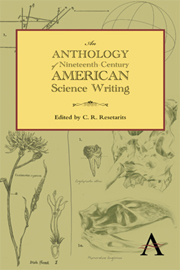Book contents
- Frontmatter
- Contents
- Preface
- Part One 1800–1846 Naturals and Naturalists
- Part Two 1846–1876 Warriors
- Part Two Introduction
- “On the Fossil Horses of America,” Proceedings of the Academy of Natural Sciences of Philadelphia (1847)
- “A Flora and Fauna Within Living Animals” (excerpt), Smithsonian Contributions to Knowledge (1853)
- “Examination of the Radiations of Red-Hot Bodies. The Production of Light by Heat” (excerpt), American Journal of Science and Arts (1847)
- “Section IX: Range of the Geographical Distribution of Animals,” Essay on Classification (1857)
- “On the Origin of Species” (excerpt), American Journal of Science (1860)
- “Darwin on the Origin of Species,” Atlantic Monthly (1860)
- “Sequoia and Its History” (excerpt), American Naturalist (1872)
- “On the Origin of the Geographical Distribution of Crustacea” (excerpt), Annals and Magazine of Natural History (1856)
- “On Cephalization” (excerpt), New Englander (1863)
- “On some Results of the Earth's Contraction from cooling, including a discussion of the Origin of Mountains, and the nature of the Earth's Interior” (excerpt), American Journal of Science (1873)
- “On Comets and Meteors,” Proceedings of the American Philosophical Society (1869)
- “Linear Associative Algebra,” A Memoir read before the National Academy of Sciences in Washington, 1870 (excerpt), American Journal of Mathematics (1881)
- “The Laws of Organic Development” (excerpt), American Naturalist (1871)
- “Fossil Horses in America,” American Naturalist (1874)
- “Odontornithes, or Birds with Teeth,” American Naturalist (1875)
- “The Genesis of Species” (excerpt), North American Review (1871)
- Part Three 1876–1900 Scientists
- Bibliography
“The Laws of Organic Development” (excerpt), American Naturalist (1871)
from Part Two - 1846–1876 Warriors
Published online by Cambridge University Press: 05 June 2012
- Frontmatter
- Contents
- Preface
- Part One 1800–1846 Naturals and Naturalists
- Part Two 1846–1876 Warriors
- Part Two Introduction
- “On the Fossil Horses of America,” Proceedings of the Academy of Natural Sciences of Philadelphia (1847)
- “A Flora and Fauna Within Living Animals” (excerpt), Smithsonian Contributions to Knowledge (1853)
- “Examination of the Radiations of Red-Hot Bodies. The Production of Light by Heat” (excerpt), American Journal of Science and Arts (1847)
- “Section IX: Range of the Geographical Distribution of Animals,” Essay on Classification (1857)
- “On the Origin of Species” (excerpt), American Journal of Science (1860)
- “Darwin on the Origin of Species,” Atlantic Monthly (1860)
- “Sequoia and Its History” (excerpt), American Naturalist (1872)
- “On the Origin of the Geographical Distribution of Crustacea” (excerpt), Annals and Magazine of Natural History (1856)
- “On Cephalization” (excerpt), New Englander (1863)
- “On some Results of the Earth's Contraction from cooling, including a discussion of the Origin of Mountains, and the nature of the Earth's Interior” (excerpt), American Journal of Science (1873)
- “On Comets and Meteors,” Proceedings of the American Philosophical Society (1869)
- “Linear Associative Algebra,” A Memoir read before the National Academy of Sciences in Washington, 1870 (excerpt), American Journal of Mathematics (1881)
- “The Laws of Organic Development” (excerpt), American Naturalist (1871)
- “Fossil Horses in America,” American Naturalist (1874)
- “Odontornithes, or Birds with Teeth,” American Naturalist (1875)
- “The Genesis of Species” (excerpt), North American Review (1871)
- Part Three 1876–1900 Scientists
- Bibliography
Summary
On the Laws of Evolution
Wallace and Darwin have propounded as the cause of modification in descent their law of natural selection. This law has been epitomized by Spencer as the “preservation of the fittest.” This neat expression no doubt covers the case, but it leaves the origin of the fittest entirely untouched. Darwin assumes a “tendency to variation” in nature, and it is plainly necessary to do this in order that materials for the exercise of a selection should exist. Darwin and Wallace's law is, then, only restrictive, directive, conservative, or destructive of something already created. Let us, then, seek for the originative laws by which these subjects are furnished – in other words, for the causes of the origin of the fittest.
The origin of new structures which distinguish one generation from those which have preceded it, I have stated to take place under the law of acceleration. As growth (creation) of parts usually ceases with maturity, it is entirely plain that the process of acceleration is limited to the period of infancy and youth in all animals. It is also plain that the question of growth is one of nutrition, or of the construction of organs and tissues out of protoplasm.
The construction of the animal types is restricted to two kinds of increase – the addition of identical segments and the addition of identical cells. The first is probably to be referred to the last, but the laws which give rise to it cannot be here explained.
- Type
- Chapter
- Information
- An Anthology of Nineteenth-Century American Science Writing , pp. 171 - 176Publisher: Anthem PressPrint publication year: 2012



